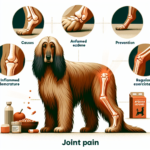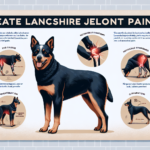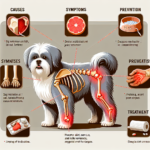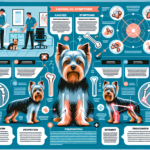Azawakh Joint Pain: Causes, Symptoms, Prevention, and Treatment
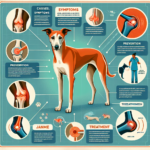
Introduction
The Azawakh is a unique and elegant breed known for its slender build, speed, and grace. Originating from the Sahel region of Africa, particularly Mali, Niger, and Burkina Faso, the Azawakh has been a loyal companion to the nomadic Tuareg people for centuries. This breed is primarily used for hunting and guarding, showcasing remarkable endurance and agility. Azawakhs are characterized by their lean bodies, long legs, and deep chests, which contribute to their exceptional running capabilities.
Despite their robust appearance, Azawakhs are prone to certain health issues, with joint pain being a significant concern. Joint health is crucial for maintaining the breed’s agility and overall well-being. Understanding the causes, symptoms, prevention, and treatment of joint pain in Azawakhs is essential for owners to ensure their pets lead healthy and active lives.
Breed-Specific Joint Pain Risks
Genetic Predisposition
Azawakhs, like many other breeds, have a genetic predisposition to joint-related issues. Hip dysplasia, a condition where the hip joint doesn’t fit properly into the hip socket, is a common concern. This can lead to arthritis and significant discomfort over time. Elbow dysplasia, another genetic condition, affects the elbow joints and can cause similar issues. These conditions are often inherited, making it crucial for breeders to screen for these problems to reduce their prevalence in future generations.
Age-Related Risks
As Azawakhs age, the risk of developing joint pain increases. The breed’s slender build and high activity levels can contribute to wear and tear on the joints over time. Owners should be vigilant about joint health as their Azawakh reaches middle age, typically around 5-7 years old. Early detection and management can help mitigate the impact of age-related joint issues.
Activity Level and Joint Stress
Azawakhs are known for their high energy levels and need for regular exercise. While this is beneficial for their overall health, it can also put stress on their joints. Activities such as running, jumping, and playing can exacerbate joint issues if not managed properly. It’s essential to balance their need for exercise with measures to protect their joints.
Common Symptoms of Joint Pain in Azawakhs
General Symptoms
- Limping: One of the most noticeable signs of joint pain is limping or favoring one leg over another.
- Stiffness: Stiffness, especially after rest or sleep, can indicate joint discomfort.
- Reluctance to Move: An Azawakh in pain may be hesitant to engage in activities they once enjoyed, such as running or jumping.
- Swelling: Swelling around the joints can be a sign of inflammation and pain.
- Behavioral Changes: Changes in behavior, such as irritability or withdrawal, can also indicate joint pain.
Breed-Specific Symptoms
In Azawakhs, joint pain may manifest more subtly due to their stoic nature. Owners should pay close attention to any changes in gait or activity levels. Azawakhs may also show signs of discomfort by licking or chewing at the affected joints.
When to Consult a Vet
If an Azawakh exhibits any of the above symptoms for more than a few days, it’s essential to consult a veterinarian. Early intervention can prevent further deterioration and improve the dog’s quality of life. Regular veterinary check-ups are also crucial for monitoring joint health.
Preventive Measures for Joint Health
Exercise Recommendations
Regular, moderate exercise is vital for maintaining joint health in Azawakhs. Activities such as walking, swimming, and controlled running can help keep their joints flexible and muscles strong. Avoid high-impact activities that can strain the joints, especially on hard surfaces.
Dietary Suggestions
A balanced diet rich in essential nutrients is crucial for joint health. Foods containing glucosamine, chondroitin, and omega-3 fatty acids can support joint function and reduce inflammation. Consider incorporating supplements specifically designed for joint health, but always consult a veterinarian before making any dietary changes.
Weight Management
Maintaining a healthy weight is critical for reducing joint stress. Excess weight can exacerbate joint pain and lead to other health issues. Monitor your Azawakh’s weight and adjust their diet and exercise routine as needed to keep them at an optimal weight.
Early Screening and Monitoring
Regular veterinary check-ups and early screening for joint issues can help catch problems before they become severe. X-rays and other diagnostic tools can identify joint abnormalities early, allowing for timely intervention.
Treatment Options for Joint Pain
Non-Surgical Treatments
Non-surgical treatments for joint pain in Azawakhs include medications, physical therapy, and lifestyle adjustments. Anti-inflammatory drugs and pain relievers can help manage symptoms. Physical therapy, including exercises and massage, can improve joint function and reduce pain. Lifestyle adjustments, such as providing a comfortable bed and avoiding slippery surfaces, can also make a significant difference.
Surgical Options
In severe cases, surgical intervention may be necessary. Procedures such as hip replacement or arthroscopy can provide relief and improve mobility. These surgeries are typically considered when other treatments have failed to alleviate the pain.
Alternative Therapies
Alternative therapies like acupuncture, hydrotherapy, and massage can also benefit Azawakhs with joint pain. Acupuncture can help reduce pain and inflammation, while hydrotherapy provides low-impact exercise that strengthens muscles without stressing the joints. Massage can improve circulation and reduce muscle tension around the affected joints.
Lifestyle and Management Tips
Daily Care Routine
A daily care routine for an Azawakh with joint pain should include gentle exercise, a balanced diet, and regular monitoring of their condition. Incorporate joint-friendly activities like swimming and ensure they have a comfortable place to rest.
Modifying the Home Environment
Making the home environment more comfortable can significantly impact an Azawakh’s quality of life. Consider using ramps instead of stairs, providing orthopedic beds, and ensuring they have non-slip surfaces to walk on.
Long-Term Management
Long-term management of joint pain involves regular veterinary check-ups, ongoing physical therapy, and maintaining a healthy lifestyle. Consistent monitoring and adjustments to their care routine can help keep your Azawakh active and happy despite joint pain.
FAQs About Azawakhs and Joint Pain
What are the early signs of joint pain in Azawakhs?
Early signs include limping, stiffness, reluctance to move, and behavioral changes. If you notice any of these symptoms, consult your veterinarian.
Can joint pain in Azawakhs be prevented?
While genetic predispositions can’t be entirely prevented, maintaining a healthy weight, providing a balanced diet, and ensuring regular, moderate exercise can help reduce the risk of joint pain.
Are there specific exercises that are better for Azawakhs with joint pain?
Low-impact exercises like swimming and walking on soft surfaces are ideal for Azawakhs with joint pain. Avoid high-impact activities that can strain the joints.
What dietary supplements can help with joint health in Azawakhs?
Supplements containing glucosamine, chondroitin, and omega-3 fatty acids can support joint health. Always consult your veterinarian before adding supplements to your dog’s diet.
When should I consider surgery for my Azawakh’s joint pain?
Surgery is typically considered when other treatments have failed to alleviate the pain and the dog’s quality of life is significantly affected. Consult your veterinarian to discuss the best options for your pet.
Conclusion
Joint pain is a significant concern for Azawakhs, given their genetic predisposition and high activity levels. By understanding the causes, symptoms, prevention, and treatment options, owners can take proactive steps to ensure their Azawakh’s joint health. Regular veterinary check-ups, a balanced diet, appropriate exercise, and early intervention are crucial for maintaining their well-being. By taking these measures, you can help your Azawakh lead a happy, active, and pain-free life.

